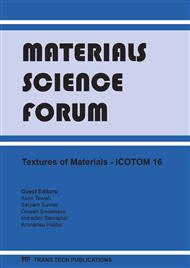[1]
F.J. Humphreys, M. Hatherly, Recrystallization and Related Annealing Phenomena, second ed., Pergamon Press, Oxford, (2004).
Google Scholar
[2]
D.A. Hughes, N. Hansen, Microstructure and strength of nickel at large strains. Acta Mater. 48 (2000) 2985-3004.
DOI: 10.1016/s1359-6454(00)00082-3
Google Scholar
[3]
G. Winther, X. Huang, Dislocation Structures. Grain orientation dependence and slip system dependence. Philos. Mag. 87 (2007) 5215-35.
DOI: 10.1080/14786430701591505
Google Scholar
[4]
P.J. Hurley, F.J. Humphreys, An objective study of substructural boundary alignment in aluminum. Acta Mater. 51 (2003) 4737-50.
DOI: 10.1016/s1359-6454(03)00277-5
Google Scholar
[5]
F.J. Humphreys, P.S. Bate, Measuring the alignment of low-angle boundaries formed during deformation. Acta Mater. 54 (2006) 817–29.
DOI: 10.1016/j.actamat.2005.10.012
Google Scholar
[6]
M.Z. Quadir, N. Mateescu, L. Bassman, W. Xu and M. Ferry, Three dimensional study of the structure of microbands in steel. Scripta Mater. 57 (2007) 977-80.
DOI: 10.1016/j.scriptamat.2007.08.012
Google Scholar
[7]
N. Afrin, M.Z. Quadir, L. Bassman, J.H. Driver, A. Albou, M. Ferry, The three-dimensional nature of microbands in a channel die compressed Goss-oriented Ni single crystal. Scripta Mater. 64 (2011) 221-24.
DOI: 10.1016/j.scriptamat.2010.10.020
Google Scholar
[8]
F.X. Lin, A. Godfrey, D.J. Jensen, G. Winther, 3D EBSD characterization of deformation structures in commercial purity aluminum. Mater. Charact. 61 (2010) 1203-10.
DOI: 10.1016/j.matchar.2010.07.013
Google Scholar
[9]
A. Albou, J.H. Driver, C. Maurice, Microband evolution during large plastic strains of stable {110}<112> Al and Al–Mn crystals. Acta Mater. 58 (2010) 3022-34.
DOI: 10.1016/j.actamat.2010.01.034
Google Scholar
[10]
A.D. Rollett, S.B. Lee, R. Campman, G.S. Rohrer, Three-dimensional characterization of microstructure by electron back-scatter diffraction. Ann. Rev. Mater. Res. 37 (2007) 627-58.
DOI: 10.1146/annurev.matsci.37.052506.084401
Google Scholar
[11]
K. King, B. Liu, M.Z. Quadir, M. Ferry, L. Bassman, Novel method for identifying low-angle subgrain boundaries. Proceedings of TMS, San Francisco (2009) 669-76.
Google Scholar
[12]
D'Errico, John, Gridfit: Applicable to Matlab 7. 0. 1 (2005).
Google Scholar


